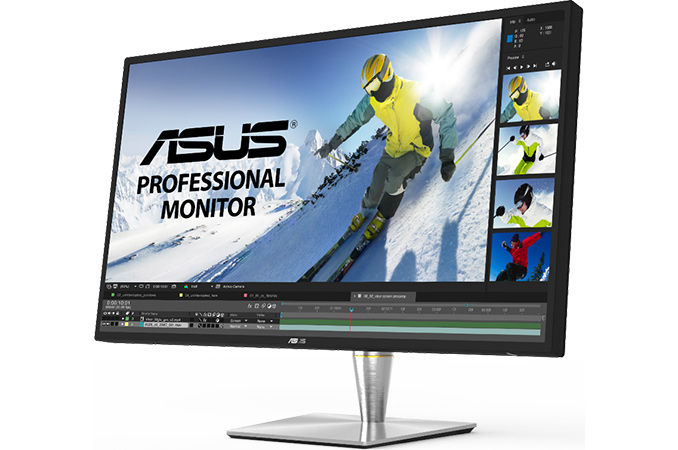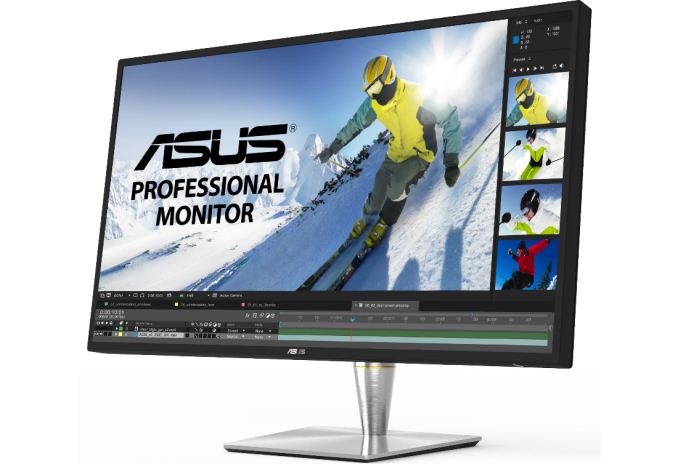ASUS ProArt PA32U Display: 4K, 1000 Nits Brightness, 95% DCI-P3, 85% Rec. 2020
by Anton Shilov on January 6, 2017 11:15 AM EST
ASUS introduced a new professional-grade monitor at CES this week. The unit supports a 4K (UHD) resolution, HDR10, a very high brightness and an astonishing range of color gamuts required by artists, designers, photographers and video professionals today, including the Rec. 2020 (BT.2020) standard. The ProArt PA32U will be available in the second half of this year at a rather hefty price tag, as you can imagine. In addition, ASUS announced its ProArt PA27AQ monitor aimed at the entry level segment of the professional market.
The ASUS ProArt PA32U uses a 4K UHD panel with HDR capabilities, a quantum dot film and a special backlight featuring 384 LED zones that enable 1000-nit brightness and support for local dimming. The manufacturer notes that its new panel with quantum dots, backlighting and calibration enable the monitor to cover 99.5% of the Adobe RGB, 85% of the Rec. 2020, 100% of the sRGB and 95% of the DCI-P3 color spaces, which makes the display particularly appealing to artists and photographers (Adobe RGB) as well as to video editors and animation designers who do post-production work for digital cinema or TV (DCI-P3 and BT.2020). The number of features, as well as the use of quantum dot technology, represents an interesting combination for a professional display. Moreover, it looks like the ASUS ProArt PA32U will be one of the first mass-market monitors supporting the Rec. 2020 color gamut at all and covering 85% of it.
| The ASUS ProArt Displays Specifications | ||
| ProArt PA32U | ProArt PA27AQ | |
| Panel | 32" with quantum dots | 27" IPS |
| Native Resolution | 4K | 2560 × 1440 |
| Maximum Refresh Rate | 60 Hz (?) | |
| Brightness | 1000 cd/m² | unknown |
| Contrast | high | unknown |
| Viewing Angles | 178°/178° horizontal/vertical (?) | |
| Pixel Pitch | 0.185 mm | 0.233 mm |
| Pixel Density | 138 ppi | 109 ppi |
| Anti-Glare Coating | Yes (?) | |
| Color Gamut | Adobe RGB: 99.5% DCI-P3: 95% sRGB: 100% Rec. 2020: 85% |
sRGB: 100% |
| Inputs | 1 × Thunderbolt 3 1 × DP 1.2 (?) |
1 × Thunderbolt 3 1 × DP 1.2 (?) |
| Extras | ASUS ProArt Calibration with color parameters saved locally | |
The ProArt PA32U monitor will be calibrated at the factory, but people with appropriate equipment will be able to further tune them their particular needs. The ProArt PA32U stores all the color parameters locally (and not on the PC), so users will be able to use it with different devices without the necessity to recalibrate it. This will be particularly valuable for those who works on Apple macOS and Microsoft Windows platforms. To hook up the monitor to either PC, the PA32U is equipped with a Thunderbolt 3 input (which means DP 1.2 over a USB-C cable), but we do not know whether other ports are supported.
Since this is a preliminary announcement, ASUS does not disclose whether it uses an IPS or VA panel, or if the TFT is ASi or IGZO (like it used for its previous-generation flagship professional display) for its PA32U as well as details about the LUTs (look-up-tables), refresh rate and so on. We do understand that the panel is an LCD based on usage of quantum dots and high, but not prohibitively high, price.
For people who do not need 4K UHD resolution, Rec. 2020 or DCI-P3 color spaces and HDR, ASUS plans to offer its 27” ProArt PA27 AQ monitor with 2560 × 1440 resolution, sRGB color gamut and Thunderbolt 3 input. The monitor will also come pre-calibrated and will support the same ProArt Calibration features as its bigger brother (color-accuracy tuning, uniformity compensation local store of parameters, etc.).
The ASUS ProArt PA32U will be available in Q3 2017 for $1799 – $1999.
Pricing of the ProArt PA27AQ (as well as its availability timeframe) are unknown.
Related Reading:
- LG Announces 32UD99: 4K IPS Display with 95% DCI-P3, HDR and USB-C
- BenQ Launches the SW320: a 4K Display with HDR for Professionals
- Panasonic Develops IPS Panel with 1,000,000:1 Contrast Ratio, 1000 Nits Brightness
- EIZO Launches ColorEdge CG2730 and CS2730 2560×1440 Displays for Professionals and Prosumers
- Dell Introduces UltraSharp UP3017 30-Inch Professional Display with 16:10 Aspect Ratio and DCI-P3 Color Space
Source: ASUS











30 Comments
View All Comments
mobutu - Friday, January 6, 2017 - link
Very nice!chaos215bar2 - Friday, January 6, 2017 - link
While it's true that all these displays technically need is DisplayPort 1.2 over USB-C (unless ASUS is throwing in some other ports driven specifically by PCIe via Thunderbolt), that's really not at all the same thing as claiming it has a Thunderbolt 3 input. A port capable of only DisplayPort over USB-C and not Thunderbolt 3 will not be capable of driving a display expecting Thunderbolt input.Morawka - Friday, January 6, 2017 - link
could this monitor achieve 100% DCI-P3 with proper calibration? like if i didnt need sRGB or Rec color accuracy?nagi603 - Saturday, January 7, 2017 - link
If it could, ASUS would have written it as 100% in the spec sheet.TristanSDX - Friday, January 6, 2017 - link
HDR with help of local dimming is sort of hack with unwanted blooming as huge downside. Seems the same tricks as dithering, 'additional' colors from FRC and similar. Look like evolution of LCD is finished with contrast 1000:1, few ms lag, viewing andles and similarhalcyon - Sunday, January 8, 2017 - link
So well said. LCD needs per pixel level backlight modulation (and quantum dots and)...HDR is an idea the techonology of which has not come yet.
hechacker1 - Friday, January 6, 2017 - link
If this thing is priced to high I don't see a point. There was a $5k dell monitor that was OLED, but unfortunately it seems Dell backtracked and turned it into an IPS / quantum dot panel.I don't get how TVs are significantly cheaper yet have OLED and all the colorspace options.
Magichands8 - Friday, January 6, 2017 - link
It's my understanding that OLED for computer monitors is a tricky proposition due to the facts that OLED has burn-in issues which would be particularly nasty for computers as many screen elements are often static for long periods of time and that computer monitors typically have much higher DPI which may complicate OLED production. TVs usually have much more screen space to work with and it's expected that the viewer will be much further away from the screen. Even LG, the king of OLED panel producers, decided to go for TV production before computer monitor production. Although I suspect that has at least as much to do with the huge markups they can get for "home theater" TVs as it does the technical obstacles to making highly dense OLED monitor panels without the pesky quality consistency issues. Take a look at the REAL OLED computer monitors from Sony and Flanders and they can set you back tens of thousands of dollars. There are reasons for that.Incidentally, I remember reading a while back that QD Vision had been able to achieve about 90% of REC 2020 coverage from their quantum dots in the lab and lo and behold now we are starting to see actual monitors being released that are approaching that. And look at how relatively cheap it is! I wouldn't pine too much over the dearth of OLED monitors. Add quantum dots to Panasonic's new LCD tech and you may end up with something that makes OLEDs pretty much obsolete.
It's going to be an interesting year for AV technology. I wonder if the big boys (Sony, Eizo, etc.) will be releasing anything new this year. As the capabilities of these prosumer sets become closer and closer to their professional offerings I think there is more and more pressure on them to keep a step ahead.
Lolimaster - Sunday, January 8, 2017 - link
Sony ones are not computer monitors, but production monitors. They can be hooked to a PC but their main function is to achieve the best fidelity so they scrap tons of panels to get the final product-scaramoosh - Friday, January 6, 2017 - link
PPI is too low, it needs to be 200+, 138 is a joke..